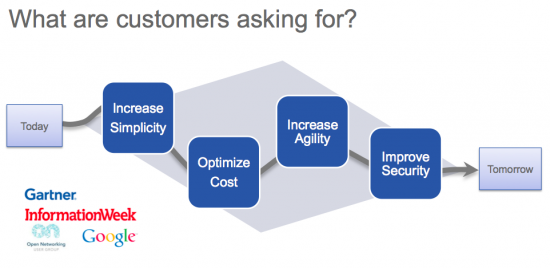































In a recent TechTarget survey, it was noted that despite the hypes about numerous benefits of SD-WAN -one of which is the ability to create a hybrid WAN environment (i.e. MPLS and Internet or LTE links), something Gartner claims will be "the new normal," -only 10% of enterprises plan to deploy hybrid WAN in the next 12 months. The greatest concern for the slow uptake is whether Quality of Service (QoS) can be done over Internet connections. In addition to that, management complexity and security vulnerabilities by going to Direct Internet Access (DIA) are also top of mind. Of the 1,437 that were surveyed, 54% is still in the consideration stage about SD-WAN, and the number one considering factor is to reduce WAN costs. This is not a surprise, but a perplexing issue for CIO, CISO, and IT Admins especially when analysts, like Gartner, and respondents in an April 2015 ETAB Survey, are prescribing SD-WAN as the enterprise's top IT priorities for the next 3-year.
We will examine the following in this post: a) the State of the WAN in 2015, b) what we hear from customers, and c) a successful, real world SD-WAN deployment.
2015 State of the WAN
Even after years of virtualization and consolidation, the WAN is a still a manual-laden process. It takes a village (design engineers, IT managers, network admins, etc.) to install, configure, manage and load any part of the network. This challenge exacerbates multifold in remote locations. As orchestration and automation happens in the data centers and the continuous drive for less costly CapEx and OpEx deployments, legacy WANs constrained by expensive private MPLS links with low feature sets and manual builds are inhibiting enterprises' ability to innovate. In the 2015 edition of Webtorials' State of the WAN report, among its findings are the following:
Access the complete report here: 2015 State of the WAN report.
What We Hear from Customers
Adoption of BYOD, IoT, cloud apps, voices and video is ever increasing and constantly demands more bandwidth and quality end user experience. In addition to the eight findings (listed above), customers also want a way to manage the network similar to how they manage applications. An approach that is proven, simplified and secured, not just for cost savings. Exhibit A below shows a consolidated view of what customers are asking.

EXHIBIT A: What Customers Are Asking For
The Value of SD-WAN
SDN brings many promises and with ONUG leading the industry in establishing an acceptable standard, technology leader like Cisco and its partner, Glue Networks, have solidified their offerings by ensuring their solutions are verified against the Top 10 Business Requirements (to learn more, read: Cisco IWAN Delivers on SD-WAN Business Requirements). SD-WAN, a part of SDN for the WAN, and its overlay approach opens up a world of simplicity not just for on-premises implementation, but also for cloud deployments. Organizations will reap both soft benefits and hard savings when they leverage the right solutions. For example, cloud-based automation enabled by solution such as Gluware delivers the following soft benefits:
When combined with an end-to-end solid platform (routing, applications visibility, WAN optimization, and integrated security), like Cisco Integrated Services Routers, hard savings can be achieved in the following areas:
Proving the Value of SD-WAN
MWH Global is a multi-national engineering firm with 7,000 employees in 180 offices across 6 continents. Its goal is to accelerate rollout of mobile project offices in remote areas, often with unreliable or unavailable Internet connectivity. To accomplish that, MWH must overcome three hurdles: 1) provisioning project office routers quickly and easily, 2) cost effectively managing and modifying technical features and services and 3) providing reliable internet connectivity in a timely fashion at a reasonable cost. Using solutions from Glue Networks and Cisco, MWH Global achieved its goal and much more. Among the benefits are the following:
For full details on this deployment, check out Nate Chessin's blog post: Glue Networks SD-WAN Deployed at MWH Global. For a quick glance at how one can provision the network using Gluware via an iPhone, check out this demo at Cisco Live Milan below.
Learn more from MWH Global
OnJuly 22, 20 15, from 10-11 a.m. PST, Cisco will host a webinar with MWH Global in joint partnership with Glue Networks. Claire Rutkowski and Andy Kimura, executives at MWH Global; Jeff Gray, chief executive officer of Glue Networks; and Robby Boyd, host of our TechWiseTV are the speakers. An overview of the agenda and link to register for both the live as well as on-demand sessions are available here: SD-WAN, A Real World Success Story.
15, from 10-11 a.m. PST, Cisco will host a webinar with MWH Global in joint partnership with Glue Networks. Claire Rutkowski and Andy Kimura, executives at MWH Global; Jeff Gray, chief executive officer of Glue Networks; and Robby Boyd, host of our TechWiseTV are the speakers. An overview of the agenda and link to register for both the live as well as on-demand sessions are available here: SD-WAN, A Real World Success Story.
In addition to that, onAugust 5, 2015, from 10-11 a.m. PST, Andy Kimura from MWH Global, Nate Chessin from Glue Networks, and Cisco technical lead, Pedro Leonardo, will return to have a deeper dive via#CiscoChat on Twitter. The team will explore further insights to help organizations navigate hypes and benefits of SD-WAN. Regardless of which stage your organization is at with SD-WAN, we encourage you to listen in and discover lessons learned from MWH Global's successes. I look forward to your attendance at both events.
 Hot Tags :
SDN
SD-WAN
deployment
Glue Networks
WAN automation
Hot Tags :
SDN
SD-WAN
deployment
Glue Networks
WAN automation